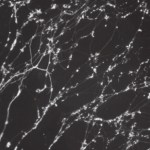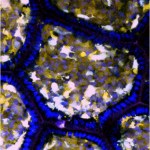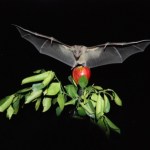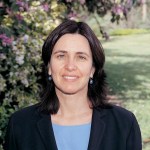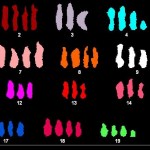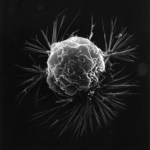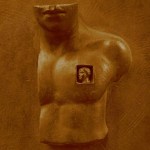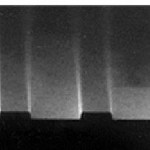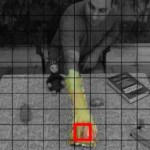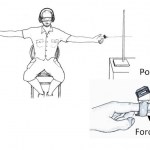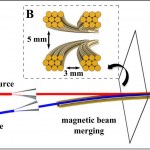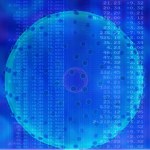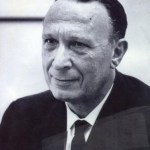
To attain knowledge, add things every day. To attain wisdom, remove things every day.
Lao Tsu
Apparently our nervous systems develop according to the Chinese philosopher’s principle of being and not being. As our nerve cells grow, they send out long extensions – axons – throughout the developing tissues. And as they reach out, some are also pruned back. The configuration of nerve endings we finally possess depends on both what was added and what was removed.
Which axons will complete their developmental journeys and which will be pruned back? For some, it is simply a matter of fate.
But in…
Have you complained about the weather recently? On the gas giants at the edges of our solar system, Uranus and Neptune, hurricane-like storm systems as big around as Earth blow 1000 km/h winds for years on end.
Voyager II image of Neptune, showing storm features. Image: NASA
But wait…What exactly constitutes weather on a giant gas planet? Here on planet Earth, there is a clearly delineated gas layer enveloping the solid/liquid layer we call home. Our weather arises from our planet’s rotation and the solar heating of its surfaces. On a rapidly-rotating gas planet (a day on Neptune is 16…
Poetry is finding its way into our consciousness at the Weizmann Institute: At the recent, fourth annual Science on Tap evening, which the Institute hosts in Tel Aviv, several poets joined in the fun, reading from their work before and after the talks given by scientists in over 60 filled-to-capacity pubs and cafes around the city. And calls have gone out for entries to the Ofer Lider creative writing contest – open to scientists (writing in Hebrew). The contest is named for Prof. Ofer Lider, an Institute scientist who, sadly, died young and who wrote poetry because he believed that…
When we navigate through our environment, do we track mostly in two dimensions or in three? Clearly, we can move in all three dimensions, but does our internal map relate to the vertical direction in the same way as it does to the horizontal axes on the ground?
That question has not yet been definitively answered, but recent research on flying bats shows us what three-dimensional navigation looks like in the brain.
It turns out that fruit bats also mostly navigate in two dimensions, since quite a bit of their flying time involves getting from their caves straight to their favorite fruit…
Prof. Shafi Goldwasser, who is at both the Weizmann Institute and MIT, will receive the 2012 A.M. Turing Award, together with Prof. Silvio Micali of MIT. Goldwasser is only the third woman to receive the Award since its inception in 1966, and she is the third faculty member of the Weizmann Institute to receive what is considered to be the “Nobel Prize in computing.”
Goldwasser and Micali’s work in the 1980s laid the foundations of modern cryptography – the science that, among other things, keeps your electronic transactions secure.
The basis of their work is a series of riffs on the…
Happy International Women's Day. In the midst of today's hand wringing about women in science, here's some good news: The Weizmann Institute has just been awarded a prize by the City of Barcelona for its efforts to promote women in science. Above: Barcelona Civil Rights councilor Francina Vila i Valls presents the award to the Institute's Dr. Karina Yaniv.
The centerpiece of this effort is the Israel National Postdoctoral Program for Women in Science, which gives grants, on top of the postdoctoral scholarships these women receive, specifically to enable them to move their families abroad…
Another advance in cancer research is featured on our website this week. Among other things, this one highlights the dangers of assuming causation from correlation. Prof. Dov Zipori and his team were looking at adult stem cells in the bone marrow. These hold a lot of potential for treating many kinds of disease but, like many kinds of stem cells, there is a risk of these cells differentiating into cancer instead of the intended normal tissue replacement. The idea was to find a marker that could tell which cells were more likely to turn cancerous, thus making the use of these stem cells safer…
New research at the Institute may offer a sliver of hope for treating “triple-negative” breast cancer. “Triple-negative” refers to the fact that the breast cancer cells are missing the three different receptors targeted by the currently available drugs, for instance Herceptin and steroid hormone blockers. This type of cancer also tends to be fairly aggressive, and the risk of early recurrence is higher than for other types of breast cancer.
Triple-negative breast cancer cells do have other receptors – particularly EGFR, a growth factor receptor that would seem to be a good target for…
What happens when a former physics-student-turned-documentary-director is invited to create a video clip for the first ever physics reunion? The answer is below.
You may not learn anything new about physics by watching it, but you will note that Weizmann President Prof. Daniel Zajfman and VP Prof. Israel Bar-Joseph are featured, along with others.
Touching Something No One Found
Does your face reveal what’s in your heart? It might – even more than you know. Take, for instance, a common group of birth defects – forms of a disorder called DiGeorge syndrome. Around one in 4000 is born with this syndrome, which arises from a deletion of a short segment of chromosome 22. Among other problems, this deletion nearly always involves deformations in both the face and the heart.
Sculpture: Igor Mitoraj
The Institute’s Prof. Eldad Tzahor had already shown that face and heart go together: Very early on in the developing embryo, the progenitor cells that will…
At the beginning of the year, we published an interview with Dr. Zohar Komargodski on this blog. Apparently we were not the only ones impressed by Komargodski’s accomplishments: The Fundamental Physics Prize Foundation has announced that he will be one of three recipients of a New Horizons in Physics Prize. This prize is given to promising young theoretical physicists, and it includes $100,000 in prize money.
We also wrote about last year’s Fundamental Physics Prizes, handed out by billionaire Yuri Milner. The new Prizes will be officially announced in March, 2013, at CERN.
Our…
Is anyone old enough to remember the ad in which two people walking down the street while snacking accidently bump into each other and discover peanut butter on a chocolate bar? Well, it turns out that when physics students run into each other on the street, the result is a quasicrystal with topological properties.
The students in question were members of two different labs in two different physics departments who were both out for a stroll on the same street in Tel Aviv – far from Rehovot and the Weizmann Institute. One was experimenting with a new kind of quasicrystalline optical system –…
Weizmann Institute scientists have created a “white smell.” Think about white light or white noise: Each mixes a bunch of different waves together from various parts of the visual or audible spectrum. Those wavelengths combine such that we perceive that unobtrusive light or sound we call “white.”
How do smells fit into this scenario? Prof. Noam Sobel and his group have already shown that smells have their own spectrum – ranging from pleasant to unpleasant – and that this relates to the chemical structure of the odor molecules. Is this spectrum truly analogous to that of light or sound? That…
The idea of “seeing the world through the eyes of a child” takes on new meaning when the observer is a computer. Institute scientists in the Lab for Vision and Robotics Research took their computer right back to babyhood and used it to ask how infants first learn to identify objects in their visual field.
How do you create an algorithm that imitates the earliest learning processes? What do you assume is already hard-wired into the newborn brain, as opposed to the new information it picks up by repeated observation? And finally, how do you get a computer to make that leap from a data-crunching…
We have been told what it’s like to be a bat or a bird; now Prof. Ehud Ahissar and Dr. Avi Saig are getting people to experience what it’s like to be a rat. Specifically, they want the participants in their studies to learn what it’s like to locate things in the dark by twitching their whiskers.
The point, of course, is not to get humans to pretend they are actually rats, but to see how they learn to sense the world with a new sense. Whisking is a fairly complex sense, involving spatial coordinates – horizontal, vertical and distance from the base of the whisker – and timing. It only works…
“The public, blog-fueled controversy over the utilization of arsenate instead of phosphate in bacteria was, in the end, a demonstration of what is truly right with scientific quests,” says Prof. Dan Tawfik. “The original findings (that certain bacteria can use arsenate instead of phosphate) may have been overhyped. The research itself may have been underwhelming. But what ensued is exactly what should have happened: The correcting mechanisms that are intrinsic to science kicked in. Other experimental groups examined the claims in their labs and found them to be unsupported. And new scientific…
Today’s post is about some cool chemistry – very cool. About 0.01°Kelvin, as a matter of fact (that is, one hundredth of a degree above absolute zero). Physics experiments conducted at such temperatures are already old hat, but chemistry is another story, altogether. Scientists have been attempting to produce chemical reactions at ultra-low temperatures for at least 50 years; a Weizmann research team has finally achieved that goal.
Why try to get reactions to take place in these conditions, which are wholly unfavorable to the usual lab-type chemistry? The answer is that when temperatures drop…
One of our constant themes is the innovative ways that tools and ideas from math and physics can lead to new insights in the life sciences. Take, for example, a recent study produced by a group that included a professor of mathematics, an oncologist who works in pharmaceutical research and has a Ph.D. in mathematics, an electrical engineer and applied mathematician who is doing a postdoc at Harvard Medical School, and physicians in a medical center research lab.
The idea was to create a mathematical model of a medical syndrome – in this case neutropenia, the low counts of the white blood…
“Imagine that you wake up in the morning feeling nothing special, yet you find yourself inexplicably behaving just a bit differently during the day. For example, you take a sniff every time you hear a tone,” says Prof. Noam Sobel. Of course, the people this actually happened to knew they had volunteered for a sleep experiment in Sobel’s lab. They knew that their sleep patterns had been closely monitored. But they had no recall, whatsoever, of the “lesson” they had learned while snoring peacefully. It was the sniffing that gave it away: While asleep, they had undergone conditioning to…
We recently witnessed the disagreement over the official memorial for the 11 Israeli athletes killed at the Munich Olympics 40 years ago. Fewer remember the terrorist attack in the Lod airport a few months earlier – in May – in which 24 people lost their lives. One of those was the head of the Weizmann Institute’s Polymer’s Department, Prof. Aharon Katzir. (Somewhat ironically, in light of the later attack, Katzir had just returned from Germany, where he had co-organized a conference with Nobel laureate Manfred Eigen.)
Aharon Katzir
Aharon Katzir and his brother, Ephraim, who would later…
